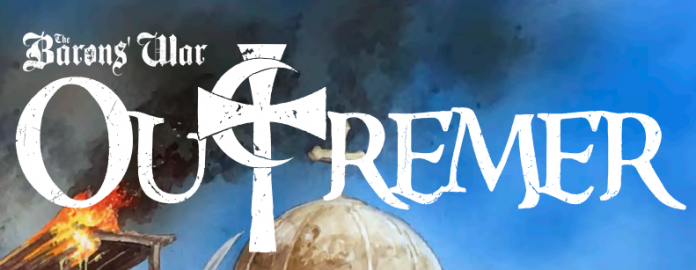Outremer is an expansion, campaign and sourcebook for taking your Barons’ War games literally “over-seas”, into the Levantine Crusader states and their Islamic neighbours. It contains army lists for Franks (westerners) in both Crusading and Settled varieties, Military Orders like the Templars and Hospitallers, the forces of Islam in dizzying variety, Bandits, Bedouin and historical figures. That alone is going to broaden your range of units and lists for Barons’ War games hugely, but more than that it also provides a really great summary of the period and a whole lot more to dig in to. Let’s have a look at what you get!
Before diving in, thanks to Footsore for sending this over!
What Is Outremer?
Just as in Conquest, Outremer is an expansion for the Barons’ War core rules, adding a huge amount of content to the base game that lets you fight the Levantine crusades from first to last. The majority of that is in the Retinue Lists, where the armies presented either use, supplement or add an entirely new faction to the Barons’ War core list.
You’re getting a really chunky expansion for your money in a sizable, very well presented A5 book. Outremer contains:
- Army lists for:
- Crusading Franks
- Settled Franks
- Military Orders
- Islamic Forces
- Bandits
- Bedouin tribes
- Rules for exhaustion
- Outremer terrain rules
- Siege Rules
- A full Campaign
- Rules for Combined retinues and Allies
That is a lot. In my opinion, Outremer is the best kind of expansion for a Historicals game – an exciting, massive play-space, presenting you with everything you need to expand a solid set of core rules into a new era (and area) while keeping tightly on theme.
What’s Different Between This and Barons’ War?
In one way, not a lot! One of the big appeals for Conquest was that loads of people have Viking, Saxon or Norman forces, so picking up Conquest let you use the basic Barons’ War rules with your existing collection. That’s also true here, and you can play Outremer with your Barons’ War forces. None of the core rules are changed in Outremer, so it’s still very much the same game. What it does do is extend the game – not just in additional traits and characteristics for list building, but in adding rules for Allied lists, Exhaustion in the desert and new terrain.
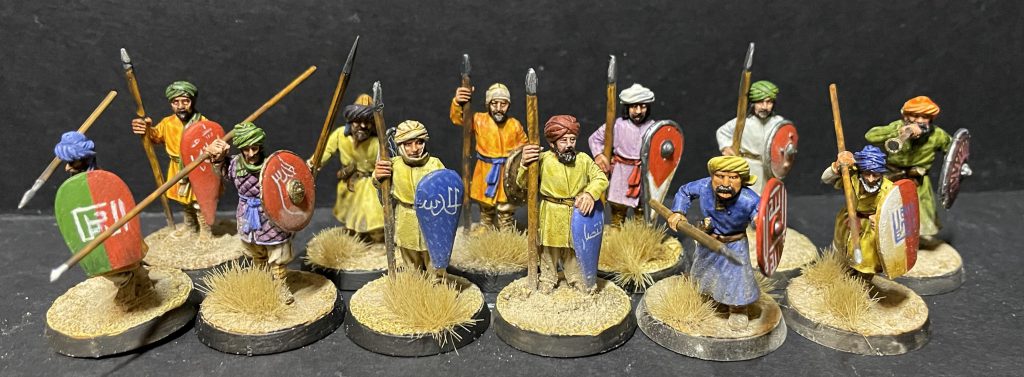
All of that adds a new context to the core rules – it’s the same game but you’re noticeably fighting in a new place against armies that use those core rules to operate very differently. While the ease of access of Conquest (“you’ve already got vikings and you know it”) might not be there as far fewer people own a Syrian army, for example, the basic rule is the same. This is the Barons’ War with very interesting twists.
The Armies
Of the six Retinue/Army types presented in Outremer, three (the Military Orders, Settled Franks and Islamic Forces) are “full” armies. Others cleverly play with special rules, army composition and abilities to twist either the Outremer lists or the core Barons’ War list into new forms.
Crusading Franks are your fresh off the boat Barons’ War armies, allowing you to take exactly the same models as your Barons’ War army does, sprinkle in some Pilgrim Rabble and make them fanatically dedicated to their cause. Though there’s lots of flexibility, their faction traits make them a bit of an unpredictable wrecking ball on the charge, so take lots of Knights and let them go for it. It’s a straightforward and simple port of the Barons’ War list, but given just enough difference through the Take the Cross and Deus Lo Vult! Faction traits to get the message across – these are your guys who were a little more sensible and cautious back in England, but now that Jerusalem is in sight it’s harder to restrain them!
Settled Franks represent the Crusaders that “stayed behind”, making lives, kingdoms and dynasties in the Levant after the first Crusade. The Kingdom of Jerusalem, Principality of Antioch and the Counties of Edessa and Tripoli find their home in this list. It’s a nice mix of new units from the Settled Franks list, largely faster and more flexible infantry than in the Crusading Franks list (and the mounted ranged threat of the Turcopoles, who look incredibly good for their cost), built around a solid core of Western Knights from the original Barons’ War book. Settled Franks are going to operate in a similar way to a standard Barons’ War list, but with a bit more speed through Turcopoles and Eastern Infantry.
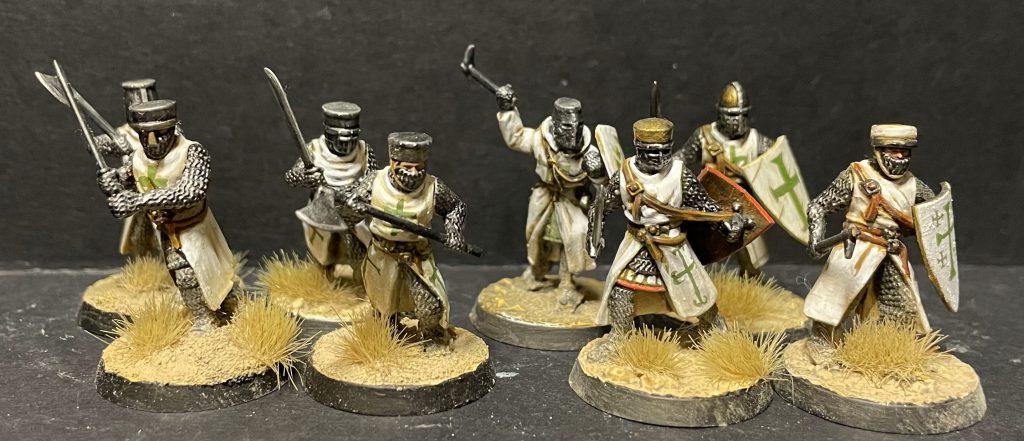
Military Orders are the Hospitalliers, Templars and other smaller Military/Religious orders that slowly became the bulwark of the shrinking Crusader states. They have the potential to be played as a hyper-elite army, ignoring the usual minimum of 10% of your points spent on Green troops. Faction traits can vary between the military orders but in every case help you to stay in the fight longer and hit harder than you’d think given the low model count you’ll probably end up with. A mass of mounted knights backed up by squires, sergeants and Turcopoles from the Settled Franks list is a good bet.
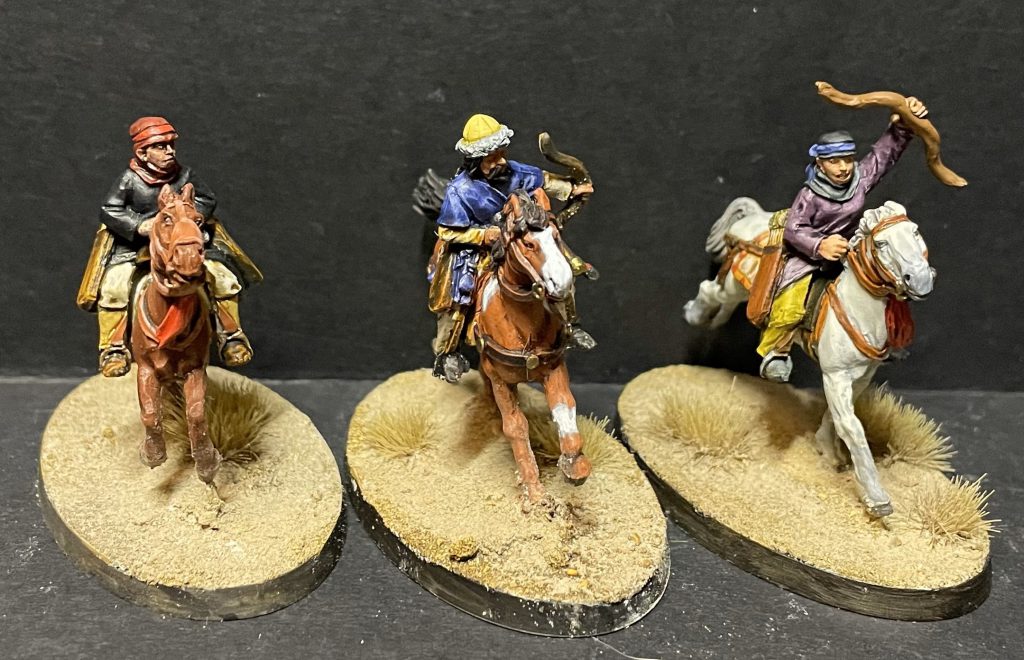
Bandits and Bedouin form two retinue lists in one, representing either Frankish (Bandits) or Islamic (Bedouin) derived forces on the edges of the conflict. You could play this as a band of thieves and robbers, a mercenary tribe, hedge knights driven from a castle or a band of deserters from either side. The number of units and abilities you can take from either/both Islamic and Frankish lists is relatively small, but you’ll be able to do some interesting tricks with rules for Ambush and Sudden Attack allowing you to out-deploy your opponent and deliver some devastating charges.
The Islamic Forces
The eagle eyed among you will notice of 6 retinue lists in the book I’ve only talked about five. That’s because the Islamic armies really need their own section, as this is an absolutely enormous retinue and I love it. The challenge for the reader is diving into it and not immediately buying a massive Islamic army (I failed). There’s a real difficulty in building Crusade-era Islamic rules to address the enormous variety of the region and period. The power blocs of Syria, Egypt, Turkic tribes, Persians and African mercenary troops all fought differently, with different organisations and tactics. These changed over time and were highly fluid with men (and tactics) moving between them. I think you can just about get away with one Crusading Franks list for “everyone leaving Europe for the Levant”, especially given the amount of customisation possible in the Barons’ War rules, you can’t with Islamic armies and that’s a big challenge for rules design.

It’s a challenge that I think Footsore have dealt with well. Not only are there 12 unit options here ranging from mountain tribesmen to fully armoured Mamluks, but many have options to represent different “nationalities” and regional fighting styles. Horse archers, for example, can be “as-is”, representing the ubiquitous light cavalry of the middle east at the time, or specialised into Turkic (faster) or Khurusanian (stop-and-shoot archers from the Iranian plateau). 12 Islamic specific abilities and six Askar (city-state) traits make for a fantastically fun list building challenge that will reward you going down the rabbit hole of reading and research while sticking to a slightly more realistic (and respectful) depiction of Islamic forces in the period.
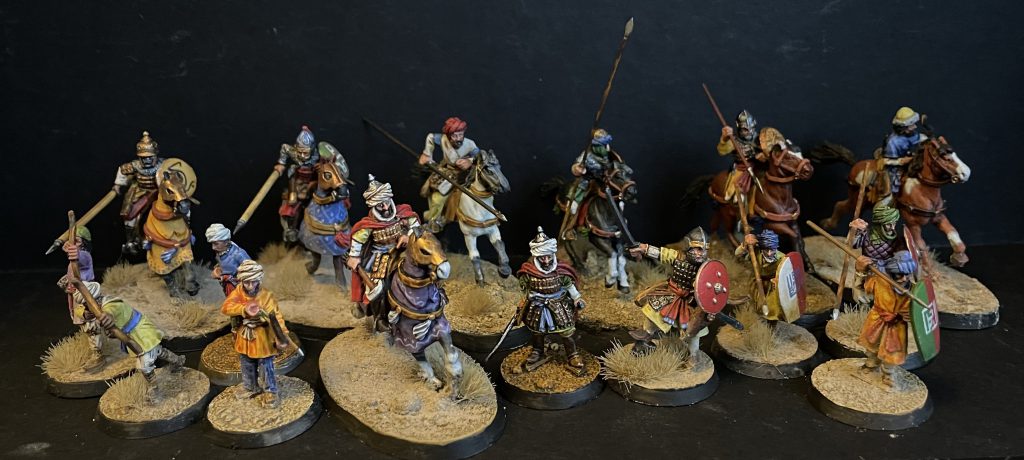
You can represent the city levies of infantry and archers with naphtha throwing support, go all light cavalry and drown an enemy in compound bow shots, tool up to take on Knights on equal footing with heavy armour, live your Old Man of the Mountains dream, or mix it all up together. You can even mix Islamic units in with the Settled Franks to represent those lords who made alliances and marriages with their Islamic neighbors. It’s fantastic! I’ve been drawn to make the retinue of poet, diplomat, schemer and general tale-teller Usama ibn Munqidh. He wrote the Book of Contemplation, a genuinely funny and absolutely fascinating collection of recollections and anecdotes about life in the Levant and encounters with the Franks. He gives a great level of detail about smaller actions perfect for the Barons’ War scale – and the flexibility of the Islamic list lets me build his core of nobles, Mamluks and dashing horse archers that he fought with. I’ll dig a bit more into this in a future article!

The Historical Background
One thing that’s been really nice reading all the Barons’ War books has been a short, but fairly comprehensive, account of the periods they cover. For the Barons’ War and Conquest these were perfectly sized to give a great overview of the conflicts (in Conquest stretching over more than a century) in a form that wargamers need – an introduction to the period, some narrative hooks, big battles and space for you to play around in. With the Outremer supplement capable of covering several centuries of highly varied conflict the introduction here is more high level, diving occasionally into more specific detail but giving you a whistle stop tour of 1097 to 1365. I think it strikes a good balance, and serves as a starting point for further research. It’s enough to get you building lists and thinking about when you’d like to set your army, with some highlights on particular battles (and crusades) without drowning you in detail. The inclusion of a further reading section is important – I think if you want to play around in Outremer, the fun bit is going to be working out exactly when and where your forces are set. The First Crusade is going to look very different to the Fourth (and Fifth, and Sixth etc etc etc), and the Islamic forces were equally, if not more, varied over time.
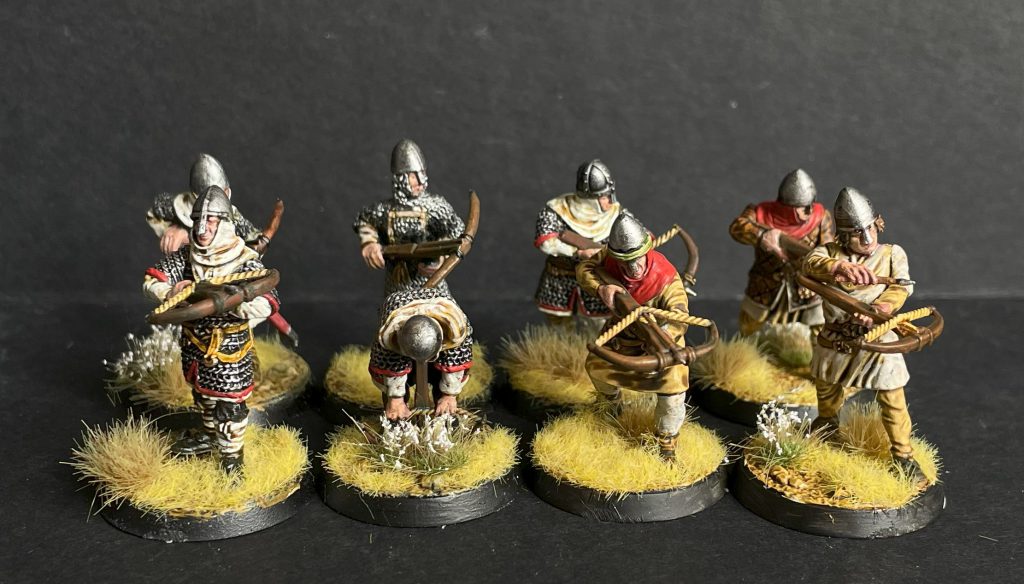
I think the important bit here is that Outremer talks about the fluidity of the political and cultural state of the area. The Franks weren’t an unstoppable out of context problem, but operated as yet another power block vying for control of the lands between Egypt and Syria, where communities did mix, acculturate and communicate. What I really like here is that that’s reflected in the lists – Frankish retinues can take elements of the Islamic lists, everyone can ally with each other into a single army and the rules reflect changing approaches to warfare over the course of the High Middle Ages.

I’d like to highlight a small but important example, the Settled Franks “Rein in” ability. This is a little thing that says a lot (always love this in a ruleset) – Settled Franks, the Western culture that arose in the levant after the first Crusade, can effectively call off a charge if it fails. Charges against highly mobile, evasive Islamic cavalry will fail occasionally/often. Being able to reposition instead of flailing around with your metaphorical arse hanging out is a powerful ability – one that the Crusader list representing forces new to the Levant don’t have, as shown above. It shows a level of adaptation to local warfare that speaks to the acclimatisation, acculturation and diplomacy that existed between the Crusader states and their Islamic neighbours. Settled Franks know how to fight mobile cavalry, because they’ve been doing it a long time – sometimes even alongside Muslim armies. For a two-line rule, that’s a clever bit of work, going above and beyond to show the complex, lived reality of the Crusader states.

As if That Isn’t Enough
As with all the Barons’ War books I’ve had the pleasure of reading, Outremer comes with a set of Dramatis Personae – historical figures rendered into appropriate stat lines. If you’d like to play Richard the Lionheart, Salah Al-Din, Sultan Baybars or John of Brienne of Jerusalem, you can! They look like interesting and often quite powerful options for you should you wish to refight historical campaigns. You can pair them up with Holy Relics, bringing even more religion to your tabletop – looking forward to seeing someone bringing the True Cross in all it’s finery and high-risk-high-reward rules someday!
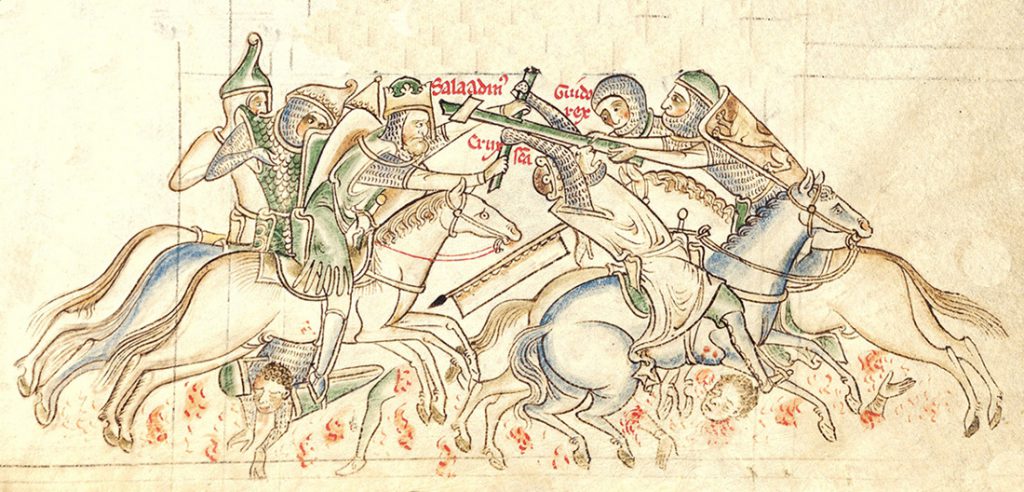
Along with characters specific to Outremer, the supplement includes additional terrain types and rules for fighting in hot climates. Sensibly, Outremer terrain is separated into areas with suggested terrain types, and notes on the relative rarity of battles in the deep desert! The majority of terrain setups for the game will look similar, if slightly more parched with slightly different trees, to those setup for the Barons’ War. It’s a similar level of terrain density, though the new terrain types introduced (Craggy areas, irrigated fields, rocky outcrops, soft sand and salt, wadis) are slightly more open than their equivalents in Europe. That suits the mounted focus of most of the Outremer Retinue lists well, and adds some good, rules-light setting and texture to your battles.
Outremer also adds exhaustion – wearing all that plate and mail in searing sunlight takes its toll. This is a relatively simple rule which will have a fairly huge effect, acting as a form of “double weary” for groups that take multiple actions in a turn and inflicting an easily remembered -2 penalty to dice rolls. It’s one of the least complex status related rules in the game, which is much appreciated as it adds an additional layer to one of most complicated systems in the Barons’ War rules
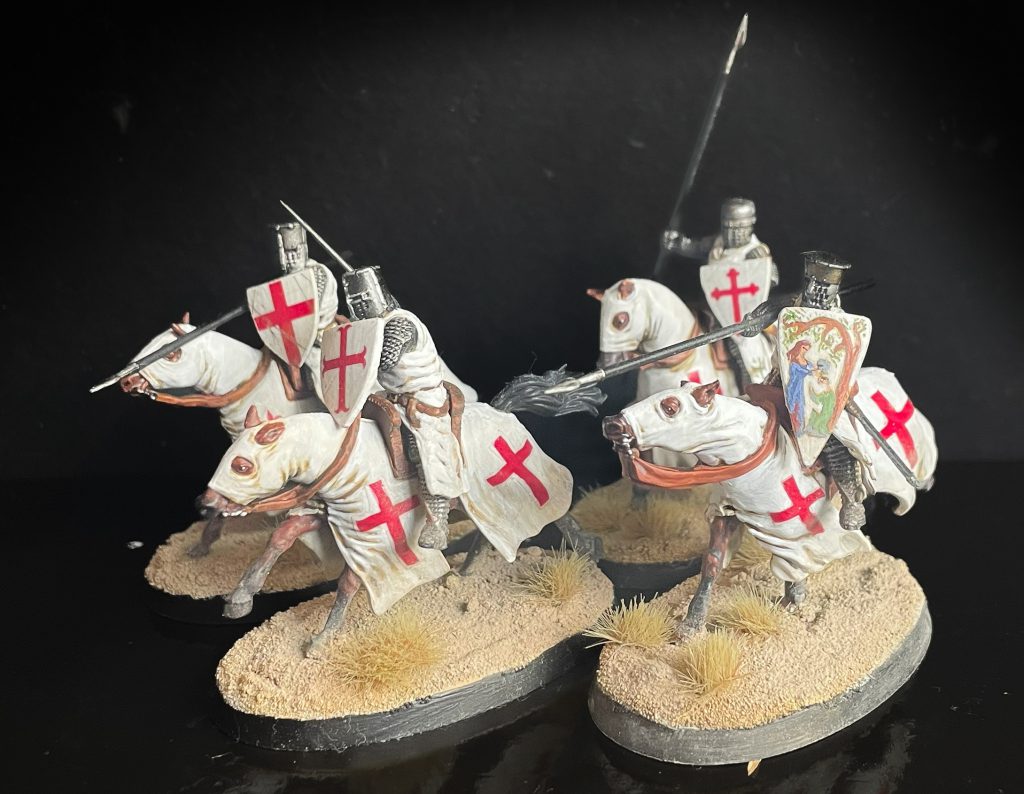
Outremer also contains a short, but perfectly formed, six game narrative campaign. It looks very interesting, introducing full siege rules, linked battles and different scales of forces to create what I’m sure is a compelling play experience. The siege rules look very interesting and I’m sure will come in handy for Barons’ War games set in any time period – you could have Anglo Danes assaulting Norman fortifications using Conquest, or one of the innumerable small sieges and castle assaults during the Barons’ War itself. I’ll come back to the campaign this when I’ve had a play, but it’s really nice to see it included. The core Barons’ War book could do with a similar short campaign – though the Campaign books footsore put out are a real steal for a couple of quid!

Why Pick This Up?
Personally, while I thought the Barons’ War rules were fantastic, the setting didn’t grab me as much – it’s a cool and interesting period, but there’s something about symmetrical skirmishes that don’t excite my imagination to the same extent. Bringing the tight and challenging ruleset over to Outremer though provides a massive new range of units, stories and campaigns to fight, ones that I’m really excited to explore. The fluidity of list building and the range of options – already massive in The Barons’ War – is going to let you theme your lists to wherever you want them to be. Saladin’s elite cavalry, embattled Templars, the Shepherds Crusade, Genoese Merchants, Bedouin tribes, scattered groups of bandits out for themselves, Ghulam and Mamluk heroes – it’s all there, and that’s really exciting. Reading through the Barons’ War: Outremer made me dream of having a massive town board, of close and desperate fighting in a border town between the Crusader states and the Caliphate, of campaigns and heroes and narratives I could play out and that is an unusually compelling feeling from reading over book that could be unfairly described as “some army lists”! I can’t wait to go from test games into the real thing and recommend you give it a go too – watch this space.
Have any questions or feedback? Drop us a note in the comments below or email us at contact@goonhammer.com. Want articles like this linked in your inbox every Monday morning? Sign up for our newsletter. And don’t forget that you can support us on Patreon for backer rewards like early video content, Administratum access, an ad-free experience on our website and more.
